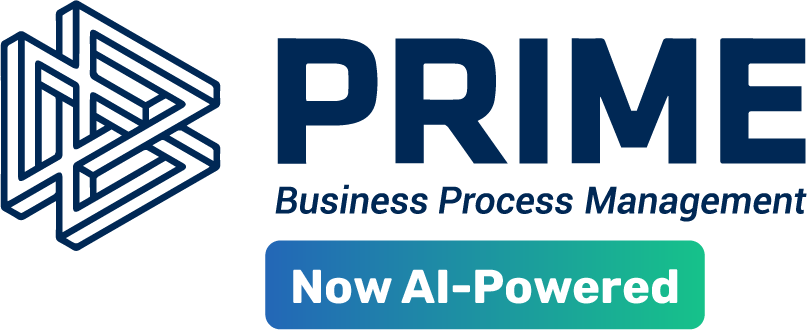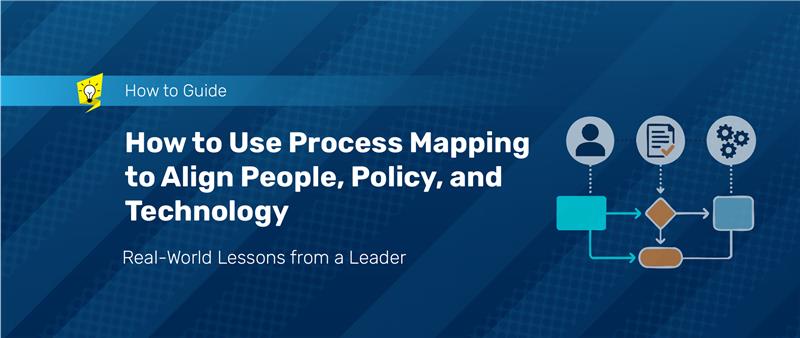Process mapping aligns people, policy, and technology by showing how work actually happens, exposing gaps and inefficiencies, and helping teams standardise workflows and improve compliance. Here’s how one local government used it to drive alignment and results and the lessons you can apply to your own initiative.
When organisations struggle with efficiency, compliance, or system change, the root cause is often not the tools, but the gaps between people, policy, and technology. Each part is working hard, but not always together.
That’s the challenge Peterborough County identified and sought to address. With an upcoming ERP replacement, paper-heavy processes, and cross-department friction, the county needed effective process mapping/modelling to see how work really happened across teams—and how to align it with policies and technology.
Dena Kempt, Corporate Process Analyst at Peterborough County shares how the county used process mapping to bridge gaps across the departments and uncover opportunities for improvement.
Bridging People–Policy–Technology Gaps with Process Mapping
Here’s how Peterborough County used process mapping to move beyond static diagrams and build real alignment—and the process mapping best practices you can apply in your own organisation.
1. Start by Seeing the Whole Process, Not Just the Tasks
Transformation often fails because organisations only see fragments of work: a form here, a system there, a policy clause somewhere else. Effective end-to-end process mapping requires understanding the entire workflow.
Through interviews with the staff who actually do the work, Peterborough County’s maps captured:
- Roles and responsibilities
- Process triggers and decision points
- Tasks, documents, systems, and software
- Time to complete each task and the whole process
- Delay time and the cost of completing the process
This moves process mapping from “drawing a flowchart” to building a full operational picture.
Lesson: Don’t treat process mapping as a drawing exercise. Treat it as a diagnostic that reveals what really happens, from trigger to outcome, including time, cost, systems, and people.
2. Use Mapping to Align People and Give Them a Voice
People are at the heart of every process, and often the biggest source of both insight and resistance.
At Peterborough County, process mapping is intentionally people-first:
- BPM specialists are treated as subject matter experts for their work.
- Sessions become safe spaces to share frustrations and ideas.
“Participants can be initially sceptical; they assume efficiency means cutting roles. Once they realise we’re trying to make their life easier, they feel empowered and excited. Sometimes it feels like a therapy session — that’s where the ideas for improvement can be generated.” — Dena Kempt
Lesson: Use process mapping as a structured way to listen. When staff realise mapping is there to support them, they become engaged partners in change, not blockers.
3. Build Cross-Department Understanding with Real Examples
Misalignment between departments is one of the biggest organisational pain points—and often invisible until you map it.
A prime example at Peterborough County was paramedic payroll:
- Payroll processed pay for all employees, but paramedics had complex inputs: shifts, overruns, missed meal windows, allowances, etc.
- There was constant back-and-forth, corrections, and questions between Paramedic Administration and Payroll.
- Payroll couldn’t understand why there were repeated delays; paramedic admin didn’t see why their process caused bottlenecks.
By mapping both sides of the process, the team discovered:
- Payroll did not need all the detailed inputs they were waiting on.
- The volume and timing of information created a bottleneck.
- Neither side fully understood the other’s constraints and workflows.
With these insights, the county updated its process: strict enforcement of cut-off times and only essential inputs sent to Payroll before processing.
Lesson: Ensure Cross-department workflow mapping from both perspectives, not just one. This uncovers friction and creates shared understanding.
4. Use Process Mapping to Test and Refine Policy in the Real World
Policies are often designed in theory—but lived in messy reality.
Peterborough County used process mapping to understand why their records retention policy wasn’t being followed:
- Many processes were still paper-based.
- Duplicate documents were stored in multiple locations (e.g., accounts payable and originating departments).
- There were no clear tasks or triggers for document destruction.
- Staff were reluctant to move away from paper; some found digital systems intimidating.
- Lack of training made it harder for staff to adopt the preferred digital storage approach.
“Mapping revealed that many processes are still largely paper-based. And often, there are no processes in place for destroying documents at the originating department.”— Dena Kempt
By mapping processes across departments, they could see:
- Where the retention policy should influence tasks.
- Where behaviour diverged from policy (e.g., printing and filing instead of digital routing).
- What needed to change—tasks, training, or system design—to support compliance.
Lesson: Don’t try to enforce policy in isolation. Use process mapping to see how policy shows up (or fails to show up) in actual workflows, then adjust tasks, training, or systems accordingly.
5. Map Before You Change Systems: Make Technology Serve the Process
With its current ERP (Great Plains) approaching end-of-life, Peterborough County didn’t start with vendor demos, they started with process maps.
Through mapping, they could:
- Identify all processes dependent on the ERP.
- See which roles and organisational units would be impacted by system change.
- Expose current system inefficiencies and workarounds.
- Inform the RFP so the new ERP supports real-world needs and policies.
- Design ideal future-state processes to guide training and implementation.
This ensures technology is chosen and configured to fit the process, not the other way around.
Dena highlighted the power of its BPM tool PRIME BPM to get these process mapping insights.
“In PRIME, we got a breakdown of all processes, roles, and units impacted by Great Plains… helping us see who we need to consult.”— Dena Kempt
Lesson: Before replacing systems, map how they’re actually used today and how they should work tomorrow. This reduces risk, improves requirements, and strengthens change management.
6. Follow a Structured, Repeatable Mapping Methodology
Peterborough County’s process mapping methodology included:
- Departmental workshop to brainstorm all processes and build rapport.
- One-on-one interviews with staff who perform the processes (and any other roles involved). .
- Draft the process map and capture frequencies and time to complete tasks.
- Review with staff to validate steps, timings, and pain points.
- Manager review to reveal hidden issues and compliance concerns.
- Corporate systems review (with Corporate Systems Integration Manager) to spot tech opportunities or gaps.
- Refine and finalise the map for use in improvement, training, or system design.
Lesson: A clear methodology makes process mapping scalable. It also signals to staff that mapping is not random; it’s a structured, serious improvement activity.
7. Ensure Top-Down Sponsorship and a Dedicated Role
Process mapping only works when the organisation is set up for it.
Success at Peterborough County is built on:
- Top-down buy-in: Senior management understands and supports the value of process mapping.
- A dedicated resource: Process mapping requires a full-time role, not something added to an already full plate.
- Clear communication of intent: Staff is consistently reassured that mapping is about efficiency and clarity—not job cuts or surveillance.
“There needs to be top-down organizational buy-in. If senior management doesn’t buy in, staff won’t either.”— Dena Kempt
Lesson: Treat mapping as a strategic capability, not a side-task. Invest in leadership alignment and dedicated capacity for successful process mapping in local government.
8. Map Proactively, Not Just in Crisis
Dena shared that while the ambition is to map all processes, reality often forces reactive mapping, especially when staff are about to retire or leave.
When mapping is done reactively. it becomes a race to capture knowledge before it walks out the door. The quality and richness of insights can be lower than in normal working conditions.
Proactive mapping, by contrast, builds resilience: knowledge is captured early and updated regularly, staff changes don’t translate into operational risk, and process ownership is clear and transferable.
Lesson: Don’t wait for a crisis to map. Build mapping into normal operations so you’re not scrambling when key people leave.
9. Treat Maps as Living Tools for Continuous Improvement
At Peterborough County, process maps are not final products, they’re living documents.
They are used to support training and onboarding, revisit and refine processes as policies, systems, and roles change, track the impact of improvements on efficiency and cost, and provide ongoing visibility into how work is actually done.
Hence, mapping is a key part of ongoing process improvement in government.
Lesson: A process map isn’t “done” when it’s drawn. It becomes most valuable when it’s revisited, questioned, and updated over time to drive continuous improvement.
Practical Takeaways for Process Mapping
- Focus on end-to-end process mapping, not in fragments – capture roles, systems, time, and cost.
- Start with people – engage staff as subject matter experts and reassure them about intent.
- Cross-department workflow mapping from both sides – especially where friction exists.
- Use mapping to stress-test policies – see where they are ignored, misunderstood, or unsupported.
- Map before you buy or replace systems – let reality shape your tech decisions and RFPs.
- Follow a clear, repeatable process mapping methodology – from workshops to reviews to refinement.
- Secure leadership support and a dedicated resource – mapping needs both authority and capacity.
- Map proactively to protect against turnover – don’t wait for key staff to leave.
- Keep maps alive – use them for training, improvement, and change management.
Drive Alignment and Transformation with PRIME BPM
Turning process mapping into a strategic alignment tool requires more than diagrams; it needs visibility, structure, and collaboration across people, policies, and systems.
PRIME BPM is an AI-powered, low code BPM platform with advanced capabilities for mapping, analysis and collaboration.
- Map process in 90% time
- Gain one-click analysis on process cost, time, value and efficiency.
- Identify process inefficiencies and bottlenecks
- Support policy compliance and system implementations (including ERP changes)
- Drive fact-based improvement to maximise ROI.
See BPM suite in action. Book a live demo to learn how PRIME BPM can help your organisation use process mapping to align people, policy, and technology—and turn operational challenges into measurable results.


